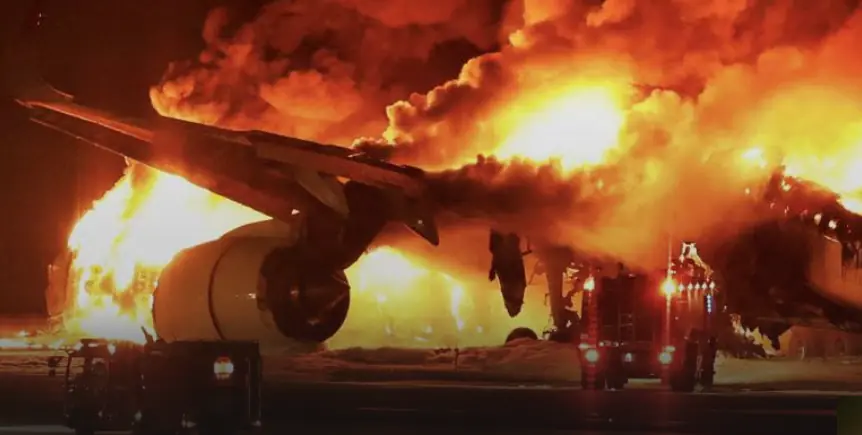
A Japan Airlines Airbus A350-900 burns after colliding on a runway with another aircraft. (Source: BBC)
JAL, the Japanese carrier that miraculously evacuated 367 passengers from a burning aircraft minutes after a runway incursion at Haneda International Airport on January 2, developed its responsibility culture decades earlier in response to the deadliest single-aircraft accident in aviation history.
Following the 1985 crash of a Boeing 747 that claimed the lives of 505 passengers and a crew of 12, Japan Airlines preserved wreckage from the JAL 123 disaster, including mangled and charred seats, personal effects and notes to loved ones written just before the crippled aircraft crashed in a mountainous area about 60 miles from Tokyo. Visitors have described viewing the remnants as an intense experience, viscerally demonstrating the consequences of safety failures.
JAL uses the recovered wreckage and searing passenger farewell notes in its safety training. That training, along with what aviation experts described as notable passenger calm and cooperation with the well-trained flight crew, prevented another disaster in January when a JAL flight landing at Haneda struck a Japanese Coast Guard plane.
The 1985 crash of the short-haul Boeing 747 aircraft was traced to a structural failure stemming from a faulty repair of an aft pressure bulkhead. Boeing engineers had attempted to repair the critical bulkhead after an earlier tail-strike incident. The failed bulkhead repair resulted in a rapid cabin decompression that ripped off the aircraft tail.
Despite complete loss of flight controls, the JAL 123 crew fought a losing battle for several minutes to regain control and return to Haneda. There were only four survivors, all badly injured.
While Japanese aviation officials sought criminal charges against Boeing for the faulty repairs, JAL’s acceptance of responsibility in the JAL 123 crash and the safety culture it spawned offers other critical lessons.
Owning it
Until recently, American agencies tended toward a comparatively passive response to transportation accidents. Displaying the twisted wreckage of an airline disaster, then using the wreckage to instill a responsibility culture that boosts aviation safety, recalls another charred flying machine: the Apollo 1 command module incinerated in a launchpad fire in January 1967. That disaster killed three astronauts and for 18 months brought America’s moon-landing quest to a screeching halt.
There’s kind of a sense of responsibility that Americans don’t quite get. You have an aviation safety culture, meaning a Japan responsibility culture….
Aviation journalist Miles O’Brien
A former NASA flight controller and space historian named James Oberg has long argued the charred Apollo spacecraft, currently stored in a formerly climate-controlled shed at NASA’s Langley Research Center in Virginia, should be taken out of mothballs and prominently displayed in Houston’s Mission Control. Oberg argues this form of remembrance would serve a purpose akin to preserving the remains of JAL 123: A stark reminder aimed at NASA flight controllers and engineers to work tirelessly in efforts to reduce inherent spaceflight risks.
The space agency is unlikely to adopt Oberg’s suggestion, but it has at least honored the crew by displaying the spacecraft hatches in a permanent Apollo 1 exhibit at the Kennedy Space Center.
Airlines, aircraft and auto manufacturers along with government agencies like NASA, the Federal Aviation Administration and the National Highway Traffic Safety Administration should embrace JAL’s approach to safety. Taking responsibility for accidents—owning them—is among the first steps toward ensuring safety, whether the mode of transport is in the air or on the ground.
“There’s kind of a sense of responsibility that Americans don’t quite get,” says aviation journalist Miles O’Brien, who has viewed the JAL 123 wreckage. Assessing the Japanese carrier’s response to the 1985 crash and its recent runway miracle, O’Brien concludes, “You have an aviation safety culture, meaning a Japan responsibility culture….”
That approach works. The proof is that 367 JAL passengers and 12 crewmembers on an Airbus A350-900 aircraft walked away on a winter evening from a fiery collision on a crowded runway.
George Leopold, a frequent contributor to the Ojo-Yoshida Report and host of the Dig Deeper Sustainability video podcast series, is the author of Calculated Risk: The Supersonic Life and Times of Gus Grissom. He and colleague Matthew Beddingfield are at work on a book about the Apollo 1 fire.
Copyright permission/reprint service of a full TechSplicit story is available for promotional use on your website, marketing materials and social media promotions. Please send us an email at [email protected] for details.
